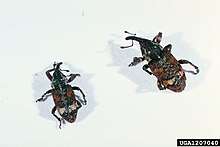Pissodes strobi
| Pissodes strobi | |
|---|---|
 | |
| Two adult Pissodes strobi | |
| Scientific classification | |
| Kingdom: | Animalia |
| Phylum: | Arthropoda |
| Class: | Insecta |
| Order: | Coleoptera |
| Family: | Curculionidae |
| Genus: | Pissodes |
| Species: | P. strobi |
| Binomial name | |
| Pissodes strobi W. D. Peck, 1817 | |
Pissodes strobi, known as the white pine weevil or Engelmann spruce weevil, is the primary weevil attacking and destroying white pines. It was described in 1817 by William Dandridge Peck, professor of natural history and botany at Harvard University. The weevil is dark brown with white spots and is native to North America.[1]
The eggs are laid inside a tree, usually white pine, Sitka spruce, white spruce, Engelmann spruce, or other pine or spruce, and the offspring feed on this tree until the host is killed.
Damage to white spruce and white pine
Severe damage to white spruce and white pine can be created by the white pine weevil. [2] Weevil resistance is a trait found in some trees and might be heritable.
A study showed that the resin (sap) released from wounds in white spruce leaders (tips) susceptible to the white pine weevil showed a different terpenoid compesition that wounds induced in resistant white pine leaders. (Tomlin et al. 2000).[3]
References
- ↑ "Forest Pest Insects in North America: a Photographic Guide -White pine weevil". Retrieved 2018-06-25.
- ↑ Kiss, G.K. 1989. Genetic improvement of white and Engelmann spruce. p. 132 in Magnussen, S.; Boyle, T.J.B. (Eds.). Proc. Part 1, 22nd Meet. Can. Tree Improv. Assoc., Edmonton AB, Aug. 1989.
- ↑ Tomlin, E.S.; Antonejevic, E.; Alfaro, R.I.; Borden, J.H. 2000. Changes in volatile terpene and diterpene resin acid composition of resistant and susceptible white spruce leaders exposed to simulated white pine weevil damage. Tree Physiol. 20:1087–1095.